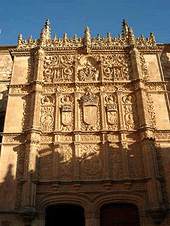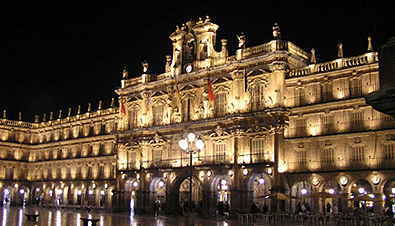 |
| IESO Quercus - Departamento de Dibujo - 2009 - Prof. Alfonso Tindon de Izu | ||||||||||||||||
 |
||||||||||||||||
| IESO Quercus I Paseo de Poniente s/n I 37190 Urb. El Encinar, Terradillos I Salamanca I Spain I T. 923373315 | ||||||||||||||||
|
|
||||||||||||||||
|
|
||||||||||||||||
|
||||||||||||||||
| Address: Paseo de Poniente s/n Postcode: 37190 City: Terradillos Region: Castilla y León Country: Spain Organisation's e- mail: ieso-quercus@jcyl.es and beyondwords@e-quercus.es Organisation's website: http://e-quercus.es/ and http://e-quercus.es/comenius/ |
||||||||||||||||
|
|
||||||||||||||||
|
|
||||||||||||||||
|
||||||||||||||||
|
||||||||||||||||
|
||||||||||||||||
|
||||||||||||||||
| SALAMANCA:"The Golden Town".
[colour] - |
||||||||||||||||
| Salamanca is probably best known for
having the oldest university in Spain and one of the oldest in Europe. This university
is still what gives good atmosphere to the town. You can see hundreds of students
passing through the streets and enjoying numerous and beautifully decorated bars
until late at night (perhaps you may wonder when they have time to study). This charming town is untouched in it's architectural purity. In central areas all recent buildings are constructed in Salamanca's best tradition. The city has been declared“World Heritage Site” by UNESCO. It is a very attractive place to visit if you are looking for cultural values, want to enjoy night life and learn a bit of Spanish. Salamanca is one of those towns which, although not large in extension, impress any of its visitors. All the buildings in the centre of town, even the new ones, are made of thestone from Villamayor, which contains a high concentration of iron making possible very filigree works, and its characteristic golden colour gives strong personality to all the town. Salamanca is exceptional and unique. UNESCO has recognised this fact, giving its old town the World Heritage designation. Plaza Mayor Square, the University, the Clerecía building, the Cathedrals, Seashells House... there is a longlist of monuments, houses and palaces to see in Salamanca, so take your time and enjoy! [more...] |
||||||||||||||||
|
|
||||||||||||||||
| SALAMANCA:"The Golden Town".
[black & white] - |
||||||||||||||||
|
|
||||||||||||||||
| SALAMANCA - World Heritage City
- |
||||||||||||||||
| The city of Salamanca has 160,415
inhabitants, or 45 percent of the entire province’s population (350,984). There is
also an important floating population in the form of students from elsewhere who
come to attend universities totalling 35,000 places, along with some 20,000 foreign students taking courses at Spanish language schools. In addition, the metropolitan area of Salamanca is made up of five municipal districts with a total population of 22,627. In short, Salamanca provides homes, jobs and education for an approximate total of 225,000 inhabitants. As far as inland Spain goes, Salamanca is one of the most popular choices among tourists. Its humanist tradition, its rich historical and artistic heritage, the colour of its Villamayor stone and its lively atmosphere earned the UNESCO title of World Heritage City in 1988. In 2002, it was chosen as European Capital of Culture and is currently a key destination on the inland tourism route. Much of Salamanca’s life revolves round the university, its students and a variety of peculiar characteristics endowing the city with a cosmopolitan, contemporary atmosphere. This is further enhanced by the arrival of people from all over the world with an interest in learning Spanish; the city’s relationship with Latin America; and the non-stop, throbbing pace of life: 24 hours of vibrancy and action. There are two universities in Salamanca: the State-run Universidad de Salamanca, with 30,446 places; and the private Universidad Pontificia de Salamanca, with 4,251. [more...] |
||||||||||||||||
|
|
||||||||||||||||
| SALAMANCA - Religious sights - |
||||||||||||||||
| A stroll through the streets of Salamanca
is the discovery at every turn of monuments steeped in history and wisdom, medieval
towers alongside Plateresque façades, and Romanesque or Neoclassical constructions
next to Baroque and Modernist buildings. This is a dynamic, welcoming city, the fruit
of its position on the Vía de la Plata and its university history. The axis that runs from the church of San Marcos, the circular plan of which constitutes an original example of the Romanesque style, to the Roman bridge over the river Tormes, takes in the most emblematic points of the city. Salamanca was called with the nickname the Little Rome appealing to the wealth of artistic, religious and cultural life that accumulates this Castilian city. City of gold, palaces and halls with coats of arms and titles. The city was repopulated during the Middle Ages with people of diverse geographical origins. Each group of people wanted to have its own church; for them the church was a meeting place and symbol of their singularity. For centuries the University of Salamanca, Spain's oldest university and one of the oldest in Europe, was the centre of scientific and religious knowledge. Its great reputation attracted the attention and interest of all religious orders. They felt the need to have a convent or monastery in Salamanca to educate their members and to represent them with dignity. Likewise, the Castilian nobility, the most influential and powerful people during the Spanish empire, sought to have their own palaces or manor houses in the town to show off their wealth and power. All these factors have contributed to the fact that Salamanca is a city crowded with monuments, either civil or religious; many of them are overshadowed by the major ones. This little guide intends to present them. [more...] |
||||||||||||||||
|
|
||||||||||||||||
| SALAMANCA - The province - |
||||||||||||||||
|
When references toSalamanca
reach our ears, our minds are full of images of the Plaza Mayor and the University,
the Roman bridge and cathedrals, the students and palaces, the House of Shells, UNESCO's
Heritage of Humanity and the European Capital of Culture. But Salamanca, happily,
is much more. In this rich territory there aresecret valleys (a refuge for numerous wildlife species), gentle towns with excellent examples of the purest traditional architecture, peaceful forests that invite you to walk through them, historical ashlars of military, civil and religious buildings preserved in time, cheerful andbustling festivities, and celebrations full of life and amusement. These are all aspects that we invite you to discover during your visit. Therefore, we present you the mosaic nature of the province reflected in its tourist districts, where we suggest a new way to get to know these wonderful places, more intimate, nearer to the roots. Salamanca is part of the Spanish region known as "Castilla y León" (Castile and Leon). Despite being a medium-size city (with around 170.000 inhabitants), Salamanca is famous in the world for its culture and for its student atmosphere. In fact, theUniversity of Salamanca is said to be the third oldest university in Europe, founded in 1218. Located in the western part of Spain, right beside the border with Portugal, Salamanca is in the inner part of the country, 200 kilometers west of Madrid and well connected by motorway. Thanks to the recently renewed airport of Valladolid, which offers flights with Ryanair and Air France, now Salamanca is an accessible destination, only at a one-hour drive from Valladolid. The city itself has an airport but only domestic flights are operated. Tourism is probably the most outstanding industry of the city, thanks to its historical heritage and to the charm of the city itself, since Salamanca can be considered one of the most beautiful Spanish cities. It is also in Salamanca, where the purest Spanish (or “Castellano”) is spoken, which makes the city a popular destination for students wanting to learn Spanish. Weather conditions in Salamanca are quite extreme, with cold winter, hot summers and few rain. In its gastronomy pork meat is the star, the cured hams produced in Guijuelo, a village in the Southern part of Salamanca, are among the most famous Spanish delicatessen. Salamanca has been declared World Heritage City by the Unesco, and in 2002, it was chosen as European City of Culture, together with Bruges in Belgium. Dance, music and art filled the streets of the city, and remain still today. You will surely enjoy your visit to Salamanca. The city of Salamanca is located in the north east corner of the province with the same name, but in every corner of the province you will find sites worth visiting. If you have some time to spare, here are some suggestions of the best places to visit. [more...] |
||||||||||||||||
|
|
||||||||||||||||
| 28/03/10 |

